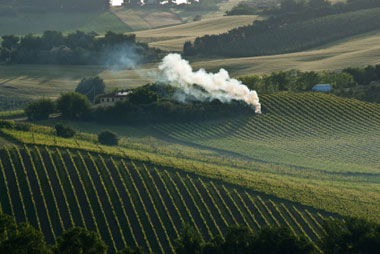Biomass Provides Air Quality benefits

Agricultural residues, such as prunings from orchards, have to be disposed of in order to allow agricultural operations to proceed unimpeded. Pushing the prunings into piles and burning them is the cheapest disposal alternative available to farmers, but the resulting pollution is one of the greatest impediments to the achievement of air-quality standards in many of the state’s major agricultural regions.
All kinds of forestry operations, ranging from commercial lumber harvesting operations to fire-reduction treatments, produce residues. Due to California’s climate, which includes a prolonged annual dry season, leaving forestry residues on the ground in the woods presents a grave fire risk, and is not allowed. Residues have to be collected and either removed, for example for use offsite as a power plant fuel, or pile-burned.
Although bioenergy facilities release emissions that impact air quality, the facilities are dramatic improvements over the emissions produced by open burning and wildfires. Further, wildfires tend to occur in late summer, when air quality is already degraded. Bioenergy produces much lower rates of emissions over the course of an entire year. Some examples of studies that evaluate the air quality improvements associated with bioenergy production include:
- The Stockholm Environmental Institute compared the GHG and air pollutant emissions for 15 different fates for forest biomass across six categories: solid waste disposal, soil amendment, residential energy (e.g. stoves), industrial energy, industrial feedstock, and liquid fuel (Lee et al. 2010) and their findings included:
- Emissions from pre-processing of residues, including the gathering, chipping and transporting residues make up less than 4% of overall emissions from all operations.
- Air pollutant emissions from burning biomass at industrial facilities (with emissions controls) result in CO and PM2.5 emissions that are much lower than emissions from uncontrolled burning on-site.
- Carbon dioxide, methane, and particulate emissions from biomass-combustion boilers were 60%, 3%, and 41% less, respectively, than the rate from pile burning in a recent study in Montana (Jones et al. 2010).
In addition to the adverse impacts of pile burning on air quality, the smoke from wildfires often mixes with atmospheric conditions downwind to create surface ozone (Pfister et al. 2008). During and after fires throughout California in 2007, the ozone produced exceeded public health standards over 100 days (Pfister et al. 2008). Particulate matter also exceeded the background level by four times downwind of fires in California (Wu et al. 2006). Removing forest biomass to promote forest health can help reduce the emissions from wildfires.
Consider the following table, which compares the air pollution from a large biomass power plant with the pollution that would be produced if the agricultural waste biomass were instead disposed of by open-burning.
| Pollutant | Open-Burn Emissions, Tons/Year | Total Power Generation Emissions, Tons/Year |
|---|---|---|
| NOx | 583 | 177 |
| CO | 5,139 | 45 |
| SO2 | 28 | 5 |
| PM10 | 825 | 28 |
| THC | 876 | 6 |
Ref (1). Power generation emissions include all emissions associated with collection and transportation of the biomass materials, and all handling machinery emissions at the power plant, plus the boiler emissions. Also see references (3) and (4).
From the table, it is evident that open burning of biomass, such as is done to dispose of crop residues and forest thinnings, produces 3 to 100 times more emissions of conventional air pollutants than controlled combustion in a biomass power plant.
In addition to these overall emissions reductions, California’s biomass fleet of facilities use the same general operation methodologies and employ various technologies to reduce individual plant emissions from the processing of biomass fuel. For example, NOx emissions are controlled by combustion modifications and add-on controls such as selective catelytic and non-catalytic reduction. Typically, these control systems are successful in simultaneously attaining low NOx and CO emission levels. Particulate matter control technologies include electrostatic precipitators, fabric filter/baghouses, wet scrubbers, and mechanical separators. No matter the specific emissions control technology, each biomass facility is operating using Best Available Control Technology (BACT)
Oversight of biomass plant emissions is covered by the local air pollution control districts who are also issuing authority for plant operating permits (Title V). The Title V Permit requires the installation of Continuous Emissions Monitor (CEMs) for O2, CO, NOx and Opacity. Continuously monitoring these critical parameters ensures consistent and efficient combustion in the boilers. Also included are fuel quality requirements, notifications requirements, regular quality assurance and emissions monitoring reports to the local air district, annual certification of compliance and regular inspections by the local air district. The US EPA has oversight review of Title V Permits. Both the local air district and the US EPA have permitting authority over significant changes in equipment or methods of operation.
The environmental regulatory oversight for biomass power plants is extensive and impact all aspects of facility operations. Air emissions is no exception.
Air Toxics “Hot Spots” Information and Assessment Act (AB 2588)
The California legislature adopted AB 2588 in 1987. It requires industrial facilities in California to inventory emissions of toxic pollutants, to assess the risks from those emissions, to inform the public if risks are greater than specified levels, and to reduce risks if specific risk levels are exceeded. ARB provides guidance and tools for completing the emission inventory, prioritizing facilities for completion of risk assessments, performing risk assessments, and providing public notice at http://www.arb.ca.gov/ab2588/ab2588.htm.